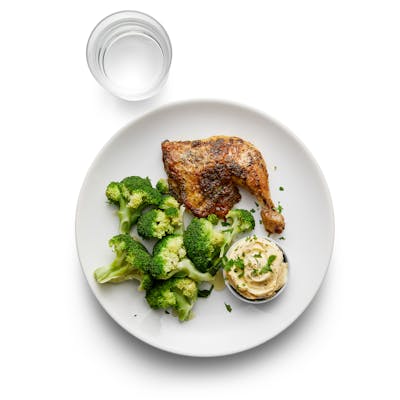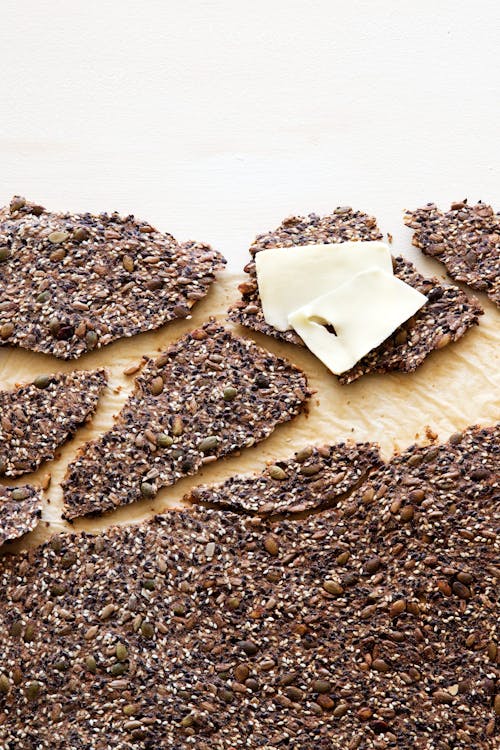How low carb is keto?
On a keto diet, how many carbs do you need to cut? How many carbs can you eat? The answer varies a bit depending on you as an individual and your goals.
In general, the fewer carbs you consume, the bigger the impact you may expect on weight loss and reduction of cravings and hunger.1 If you have type 2 diabetes, the fewer carbs you eat, the faster your blood glucose and insulin resistance might improve.2 Some, however, find a very low-carb diet too restrictive and challenging.
Here are three examples of how a low-carb dinner can look, depending on how many carbs you eat per day (the yellow stuff is delicious herb butter).
Ketogenic
Under 20 grams per day
Moderate
20-50 grams per day



Liberal
50-100 grams per day



We define low carb as anything under 100 grams per day. Note that a Western diet often has 250 grams of carbs per day, or even more.4
Learn more about the carb level that’s right for you:
How we define low carb and keto
At Diet Doctor, we define the different levels of carb intake this way:
- Ketogenic low carb <20 grams of net carbs per day.5 This level of carbohydrate intake is defined as below 5 energy percent (E%) carbs in our recipes or, if it is a meal, 7 grams of carbs or less.6 In our ketogenic recipes the amount of carbs per serving is shown in green balls.
- Moderate low carb 20-50 net grams per day. This level is defined as between 5-10 E% carbs in our recipes and the amount of carbs per serving is shown in yellow balls.
- Liberal low carb 50-100 net grams per day. This means 10-20 E% carbs in our recipes and the amount of carbs per serving is shown in orange balls.
Note: Although our recipes are arranged by percent calories from carbs, protein, and fat, we do not feel you need to calculate these on your own. We provide them as a reference, but practically we recommend you limit your carbs, ensure adequate protein, and adjust fat as needed for satiety and taste. That eliminates the need to constantly calculate “percent macros.”
Fiber and net carbs
Our listed carb counts are the number of digestible carbs, also called net carbs. This simply means we do not count the fiber.7 For example, you can eat nearly all the fiber you want from keto vegetables without seeing a significant blood sugar or insulin impact.8
However, be very careful of the term “net carbs” on labels of low-carb products, processed foods, protein bars, and energy/chocolate bars. Manufacturers often use “net carbs” as a way to disguise sugar alcohols that may slow weight loss and impact blood sugar.9 In fact, try to avoid any processed product that lists “net carbs” on a label. Learn more about keto sweeteners
The most effective keto diet — and the healthiest — is likely based on natural, whole foods.10 Learn more
What carb level to choose?
Do you need to stick to a keto diet, consuming under 20 grams of carbs a day? Or would you have good results with a moderate low carb diet, consuming 20 to 50 grams of carbs a day?
People with a lot of weight to lose, type 2 diabetes, insulin resistance, metabolic syndrome or sugar and/or food addiction, may find that they get their best results on a keto diet, keeping carbs very low.11 When starting out, however, they may experience side effects, like the keto flu, until they become better adapted to burning fat for energy.
People who want to lose pounds but still have good insulin sensitivity, have less weight to lose, or still have good blood sugar levels can often do very well on a moderate or even liberal low carb diet.12 With higher carb intake, they are also less likely to experience significant side effects. Lean, active, and healthy individuals can also do very well on liberal low carb.
We believe many people may do best starting out on a strict keto diet.13 This will give you the best idea of whether you like how you feel and what sort of results you get. Then, as you hopefully achieve your health and weight goals, you can decide whether to add more carbs back into your diet to a level where you feel your best and can maintain your health improvements.
Here’s a two-week get-started guide to a keto diet
However, if you feel that avoiding most carbs is too hard, it’s also possible to obtain health benefits by just avoiding the worst carbs.14 Perhaps this can be the right start for you? In that case, feel free to use the guide below:
Eating better: Six steps down the carb mountain
Start your FREE 7-day trial!
Get instant access to healthy low-carb and keto meal plans, fast and easy recipes, weight loss advice from medical experts, and so much more. A healthier life starts now with your free trial!
Start FREE trial!
More
Visual guide
How low carb is keto? - the evidence
This guide is written by Dr. Andreas Eenfeldt, MD and was last updated on June 19, 2025. It was medically reviewed by Dr. William Yancy, MD on March 5, 2021 and Dr. Michael Tamber, MD on February 28, 2022.
The guide contains scientific references. You can find these in the notes throughout the text, and click the links to read the peer-reviewed scientific papers. When appropriate we include a grading of the strength of the evidence, with a link to our policy on this. Our evidence-based guides are updated at least once per year to reflect and reference the latest science on the topic.
All our evidence-based health guides are written or reviewed by medical doctors who are experts on the topic. To stay unbiased we show no ads, sell no physical products, and take no money from the industry. We're fully funded by the people, via an optional membership. Most information at Diet Doctor is free forever.
Read more about our policies and work with evidence-based guides, nutritional controversies, our editorial team, and our medical review board.
Should you find any inaccuracy in this guide, please email andreas@dietdoctor.com.
The idea that eating fewer carbs is more effective is mainly based on the consistent experience of low-carb practitioners, and stories from people trying different levels of carb restriction. [weak evidence]
The only intervention study – to our knowledge – that compared different levels of carb restriction was a small trial that found non-significant trends toward greater weight loss and greater improvements in cardiometabolic risk factors as carb intake went lower.
PeerJ 2019: Low-carbohydrate diets differing in carbohydrate restriction improve cardiometabolic and anthropometric markers in healthy adults: a randomised clinical trial [moderate evidence]
Ketogenic diets have been found to reduce appetite:
Obesity Reviews 2014: Do ketogenic diets really suppress appetite? A systematic review and meta-analysis [strong evidence]
Obesity (Silver Spring) 2011: Change in food cravings, food preferences, and appetite during a low-carbohydrate and low-fat diet. [randomized controlled trial; moderate evidence]
↩Glycemic control appears to improve more as carb intake decreases:
Journal of the American Dietetic Association 2008: Restricted-carbohydrate diets in patients with type 2 diabetes: a meta-analysis [moderate evidence, downgraded because the included RCTs compare low carb to other diets, not low carb to lower carb.]
This is also based on the consistent experience of low-carb practitioners, and stories from people trying different levels of carb restriction [weak evidence].
Low-carb diets have been shown to help reduce or even normalize blood sugar in type 2 diabetes:
Diabetes Research and Clinical Practice 2018: Effect of dietary carbohydrate restriction on glycemic control in adults with diabetes: A systematic review and meta-analysis [strong evidence]
BMJ Open Diabetes Research and Care 2017: Systematic review and meta-analysis of dietary carbohydrate restriction in patients with type 2 diabetes [strong evidence]
A non-randomized trial with risk of financial bias shows that a ketogenic diet can be remarkably effective in the treatment of type 2 diabetes:
Diabetes Therapy 2018: Effectiveness and safety of a novel care model for the management of type 2 diabetes at 1 year: An open-label, non-randomized, controlled study [weak evidence]
Diabetes Research and Clinical Practice 2018: Effect of dietary carbohydrate restriction on glycemic control in adults with diabetes: A systematic review and meta-analysis [strong evidence]
Annals of Internal Medicine 2014: Effects of low-carbohydrate and low-fat diets: a randomized trial [moderate evidence]
↩Adults in the US consume about 50% of their calories from carbohydrates, or about 250 grams of carbs per day if eating 2000 calories:
Net carbs = digestible carbs, i.e. total carbs minus fiber. ↩
The limit of five percent energy means that, if eating 2000 calories/day, five percent (or less) of your calorie intake will come from carbs. In practical terms, this means you’ll stay below a maximum of 20 grams of carbs on a 2,000-calorie diet, even if you only choose our most carb-rich keto recipes. In most cases, you’ll end up with far fewer carbs than that, as some of the keto recipes you use are likely to have significantly less than the maximum amount of carbs. ↩
Although some low-carb experts disagree, it’s generally accepted that humans lack the enzymes needed to break down fiber and absorb it into the bloodstream. Therefore, the fiber portion of carbs typically does not raise blood sugar or insulin levels.
Nutrients 2010: Effects of dietary fiber and its components on metabolic health [overview article; ungraded] ↩
Fiber does not directly affect blood sugar levels, though it can indirectly slow down the absorption of digestible carbohydrates that you eat.
Fiber can have both beneficial and some potential negative effects on gut health, but it usually has no major impact on the effects of a low-carb diet. ↩
For instance, maltitol – a very common sweetener in low-carb products – has the highest glycemic (35) and insulinemic (27) indexes of all sugar alcohols.
Nutrition Research Reviews 2003: Health potential of polyols as sugar replacers, with emphasis on low glycaemic properties [overview article; ungraded]
About 50% of maltitol is digested and absorbed in the small intestine, like other carbs.
Gastroenterology 1990: Digestion and absorption in the human intestine of three sugar alcohols [randomized controlled trial; moderate evidence]
Gastroentérologie Clinique et Biologique 1991: Clinical tolerance, intestinal absorption, and energy value of four sugar alcohols taken on an empty stomach [randomized controlled trial; moderate evidence]
↩This is mainly based on evolutionary theories and clinical experience. [weak evidence]
Focus on eating good quality, minimally processed whole foods. Ideally, the food you buy shouldn’t even have a list of ingredients (or it should be very short).
Unprocessed or minimally processed whole food is what our ancestors have been eating for millions of years, and what the human animal is evolutionarily adapted to. By introducing processing, e.g. refining carbohydrates in a way that increases the speed of absorption and reduces the amount of nutrients and fiber, we change the food into something to which our bodies may not be adapted, increasing the risk of adverse health effects.
Learn more: What are you designed to eat? ↩
This is mainly based on the consistent experience of low-carb practitioners, and stories from people trying different levels of carb restriction. [weak evidence]
The only small intervention study – to our knowledge – that compared different levels of carb restriction found trends toward larger effects with fewer carbs, on weight loss and cardiometabolic risk factors. However, these trends did not reach statistical significance:
PeerJ 2019: Low-carbohydrate diets differing in carbohydrate restriction improve cardiometabolic and anthropometric markers in healthy adults: a randomised clinical trial [moderate evidence]
Regarding sugar/food addiction, this can be improved by avoiding the high-reward foods that stimulate cravings, most of which are processed foods full of sugar and/or other refined carbohydrates. [clinical experience, weak evidence]
Keto diets have also been shown to reduce hunger:
Obesity Reviews 2014: Do ketogenic diets really suppress appetite? A systematic review and meta-analysis [strong evidence]
Frontiers in Psychology 2015: Ketosis, ketogenic diet and food intake control: a complex relationship [overview article; ungraded]
↩PeerJ 2019: Low-carbohydrate diets differing in carbohydrate restriction improve cardiometabolic and anthropometric markers in healthy adults: a randomised clinical trial [moderate evidence] ↩
Unless there’s a specific reason for you not to do this.
Whether people go on a low-carb or a low-fat diet, they tend to lose weight as long as they minimize sugar and refined flours in their diet:
JAMA 2018: Effect of low-fat vs low-carbohydrate diet on 12-month weight loss in overweight adults and the association with genotype pattern or insulin secretion [randomized controlled trial; moderate evidence]
Read more about the above study in our analysis.
Here are more studies and overview articles showing a connection between sugar, excess weight and disease:
JAMA Internal Medicine 2014: Added sugar intake and cardiovascular diseases mortality among US adults [observational study; weak evidence]
Nutrition & Metabolism 2005: Fructose, insulin resistance, and metabolic dyslipidemia [overview article; ungraded]
The American Journal of Clinical Nutrition 2007: Potential role of sugar (fructose) in the epidemic of hypertension, obesity and the metabolic syndrome, diabetes, kidney disease, and cardiovascular disease [overview article; ungraded]
↩



















